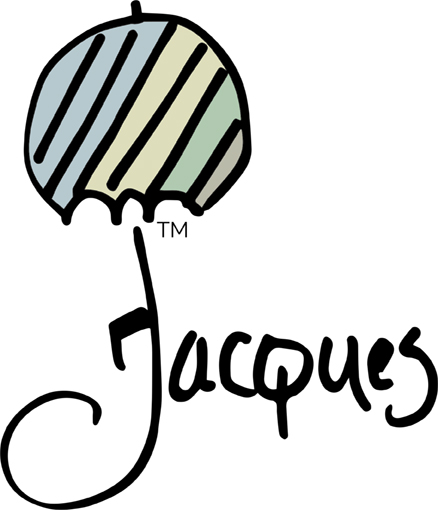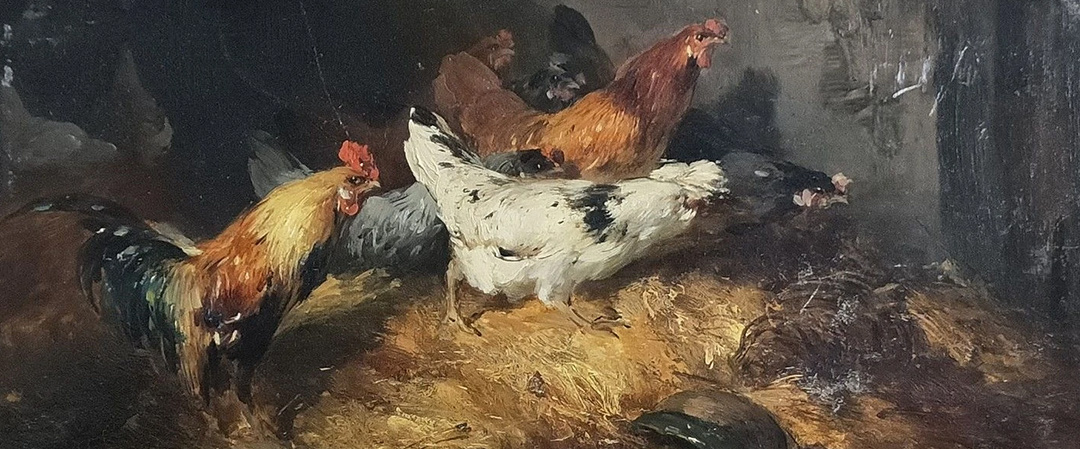“If I didn’t start painting, I would have raised chickens.”
Grandma Moses
One of Jacques’ favorite subjects (in his artist’s studio and in the kitchen) is the chicken. He even recently published a book entitled “The Art of the Chicken”. Here is some interesting information on how the chicken came to be a ubiquitous part of life.
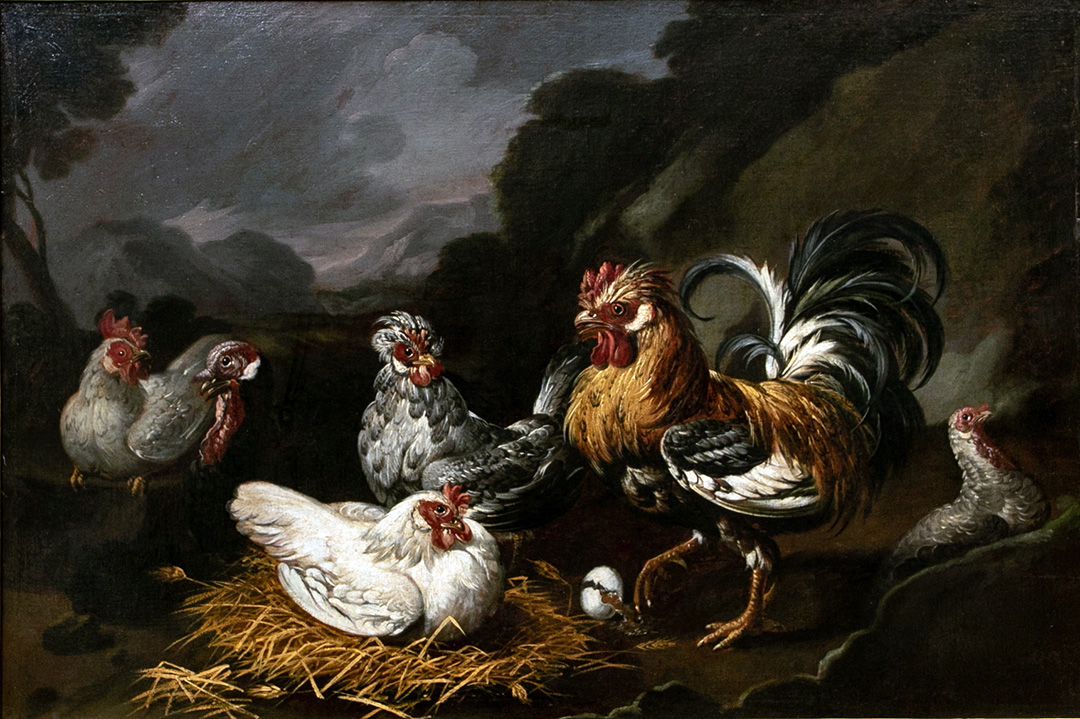 Smithsonian Magazine: “How the Chicken Conquered the World” [*]
Smithsonian Magazine: “How the Chicken Conquered the World” [*]
“The epic begins 10,000 years ago in an Asian jungle and ends today in kitchens all over the world: The chickens that saved Western civilization were discovered, according to legend, by the side of a road in Greece in the first decade of the fifth century B.C. The Athenian general Themistocles, on his way to confront the invading Persian forces, stopped to watch two cocks fighting and summoned his troops, saying: “Behold, these do not fight for their household gods, for the monuments of their ancestors, for glory, for liberty or the safety of their children, but only because one will not give way to the other.” The tale does not describe what happened to the loser, nor explain why the soldiers found this display of instinctive aggression inspirational rather than pointless and depressing. But history records that the Greeks, thus heartened, went on to repel the invaders, preserving the civilization that today honors those same creatures by breading, frying and dipping them into one’s choice of sauce. The descendants of those roosters might well think—if they were capable of such profound thought—that their ancient forebears have a lot to answer for.
Chicken is the ubiquitous food of our era, crossing multiple cultural boundaries with ease. With its mild taste and uniform texture, chicken presents an intriguingly blank canvas for the flavor palette of almost any cuisine. A generation of Britons is coming of age in the belief that chicken tikka masala is the national dish, and the same thing is happening in China with Kentucky Fried Chicken. Long after the time when most families had a few hens running around the yard that could be grabbed and turned into dinner, chicken remains a nostalgic, evocative dish for most Americans. When author Jack Canfield was looking for a metaphor for psychological comfort, he didn’t call it “Clam Chowder for the Soul.”
*Quotation above is taken directly from the website cited and is the property of that source. It is meant to inform the reader and to give credit where it is due.
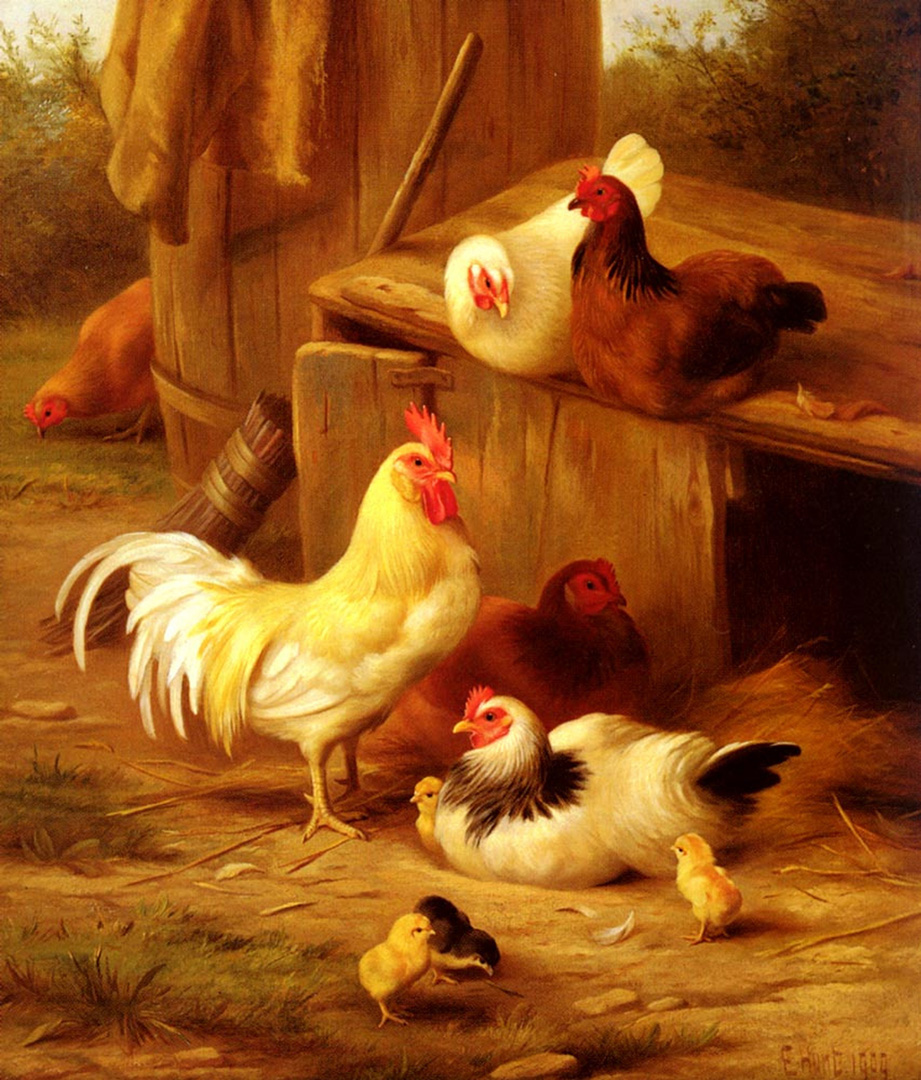 Penn State Extension: “History of the Chicken” [*]
Penn State Extension: “History of the Chicken” [*]
“Domestication of the chicken dates back to at least 2000 B.C. and their ancestry can be traced back to four species of wild jungle fowl from Southeast Asia: However, the Red jungle fowl (Gallus gallus or Gallus bankiva) is the most commonly found wild species in the world today and is considered the main ancestor of the domestic chicken. The chicken belongs to the genus Gallus of the family Phasianidae. Domestic chickens are simply classified as Gallus domesticus.
The sport of cockfighting had tremendous influence not only in the domestication of the chicken but also on the distribution of fowl throughout the world. After centuries of selection and breeding for numerous extremes, chickens now exist in many colors, sizes and shapes. There are more than 350 combinations of physical features known today. In 1873, the American Poultry Association was organized for the purposes of adopting standards of excellence and establishing a way of classifying the various breeds.
Although the purebred poultry industry served as the foundation for the development of the commercial industry, the two industries soon developed very different types of domestic fowl. While the purebred exhibition industry continued to select and breed fowl for standard conformations and plumage colors, the commercial industry developed specialized hybrids for meat and egg production. Today, the two industries are very different: The purebred fowl of today are basically the same as they were 100 years ago and are mainly raised as a hobby; whereas, the commercial poultry industry has developed into a science, which produces highly nutritious meat and eggs with extreme efficiency.”
*Quotation above is taken directly from the website cited and is the property of that source. It is meant to inform the reader and to give credit where it is due.
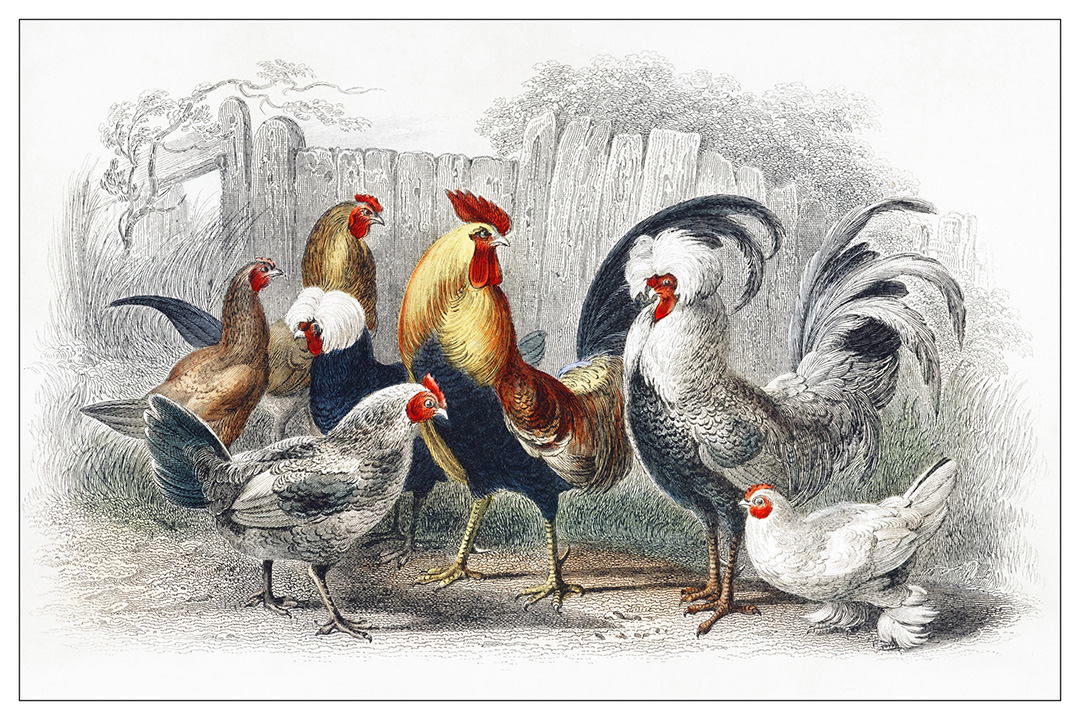 Chickens & More: “The Complete History of Chickens: From Jungles to Backyards” [*]
Chickens & More: “The Complete History of Chickens: From Jungles to Backyards” [*]
“The origins of the modern-day chicken are rather mysterious. Whilst they can be traced back to several ancestors and regions, it is generally agreed upon that most chickens are descendants of the red jungle fowl (Gallus gallus) from Southeast Asia. It is also believed that the gray jungle fowl (Gallus sonneratii) was another ancestor, as several modern-day chicken breeds have similar traits to them (such as yellow skin). The red jungle fowl was incredibly skittish and nothing like the backyard chicken breeds of today. They spent most of their time hiding in trees and would eat insects and any seeds that they could find. They would even snack on the occasional lizard and baby snake as well. Interestingly they could also fly much better than today’s chickens.
First Interactions with Humans: The red jungle fowl were first domesticated by humans in the Indus valley around 2000 BC. At this time natives originally used chickens for cockfighting which was a popular form of entertainment where chickens were provoked to fight each other. Sadly these matches often resulted in the death of one or both chickens. Chickens that were aggressive and possessed high stamina and strength were prized. This lasted for around 500 years until the Indus valley was invaded by Aryans in 1500 BC. The Aryans discovered these chickens and decided to use these birds in their ceremonial rituals and culture – they were often used as sacrifices to their deities. Whilst chickens were still not technically used as a food source, it should be noted that they were often eaten as part of the ceremonial rituals. Chickens were then transported to other regions such as Persia and Mesopotamia. Eventually they reached Greece, North Africa and the Romans in southern Italy. It was in Greece where chickens were first routinely used as a food source. However chicken meat was only eaten by the poor. The second instance of chickens being used as food was with the Romans. Although chickens were still being used as sport entertainment and for ceremonies, the Romans discovered that chickens were also an excellent source of meat..”*Quotation above is taken directly from the website cited and is the property of that source. It is meant to inform the reader and to give credit where it is due.
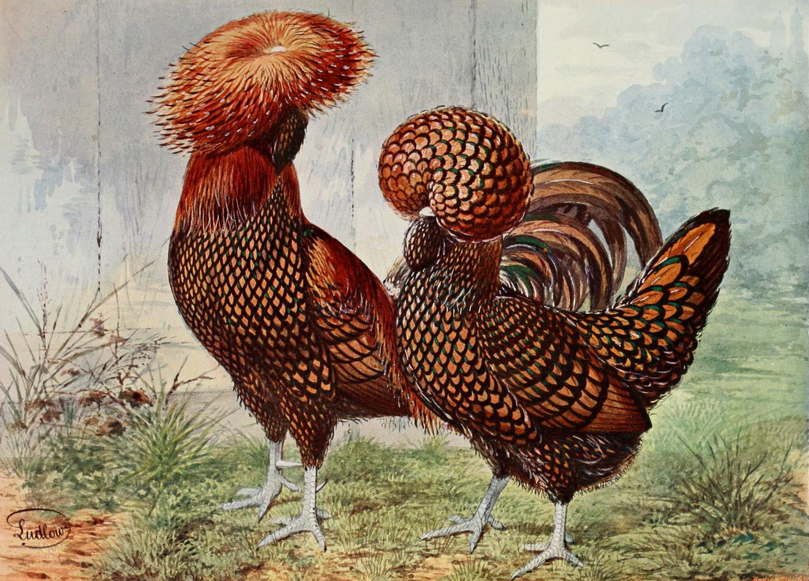 The Happy Chicken Coop: “A History of Chickens: Then (1900) vs. Now (2022) [*]
The Happy Chicken Coop: “A History of Chickens: Then (1900) vs. Now (2022) [*]
“When talking about the history of chickens, the chickens today are spoiled beyond belief compared to Grandmas’ hens. Hens of the past (1900s) had no regular access to essential commodities such as water and feed- this severely limited their egg-laying rate and also the size which they grew. The chicken wasn’t considered a necessary ‘livestock’ animal on the farm. The meat was only eaten on very special occasions and eggs were a luxury. Today, we will look back at the Humble Homestead Hen over the years and see how her lot has improved.
History of Chickens: When Did Chickens First Appear? The origin of chickens is mysterious. No scientist can pinpoint the exact place or year of origin of these birds. Generally, chickens were documented first to appear between 4,000 to 10,500 years ago. It was said to originate in Southeast Asia, northern China, and India. The Southeast Asian Red Junglefowl is said to be the original wild ancestor of chickens. However, certain variations evolved over time and in different places until we have the kind of chickens today. Because of these, some scientists may have lost track of the rare breeds of poultry, pointless to even retrace them now.”*Quotation above is taken directly from the website cited and is the property of that source. It is meant to inform the reader and to give credit where it is due.
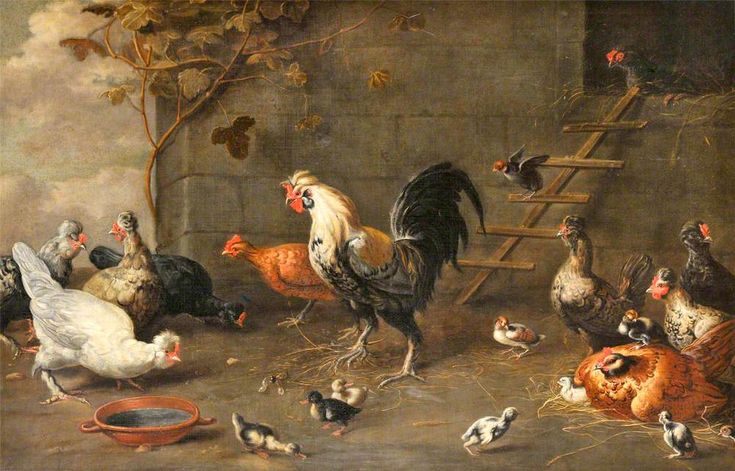 The New York Times: “Before Chickens Were Nuggets, They Were Revered” [*]
The New York Times: “Before Chickens Were Nuggets, They Were Revered” [*]
“The origin of the domestic fowl is more recent than previously thought, but it may have taken them thousands of years to become food. The real chicken mystery has nothing to do with whether the egg came first. Scientists would like to know when, where and how a bird of the jungle came together with human farmers to begin down the path that eventually led to the Popeyes chicken sandwich.
The more bioarchaeologists and evolutionary biologists delve into the deep past of the chicken, the more complex its history becomes, and the more difficult it is to imagine a time when they were not food. But recently, scientists have been reconstructing a past in which the birds, descendants of the red jungle fowl, were first viewed by humans as marvelous and exotic, then sometimes sacrificed to ancient gods and sometimes revered as status symbols.
Details of when and where the chicken was domesticated were debatable. The picture that had emerged was one of early domestication 8,000 or more years ago, possibly in China or India or Southeast Asia. But a pair of companion articles released Monday in the journals Proceedings of the National Academy of Sciences and Antiquity offered an updated origin story, putting the emergence of the domestic chicken closer to 3,500 years ago in what is now Thailand.
The reports also propose a new hypothesis for how domestication occurred. The researchers argue that the first archaeological evidence of domestic chickens coincides with the advent of rice and millet cultivation in dry fields that attract the jungle fowls, bringing them out of the forest into regular contact with people.”*Quotation above is taken directly from the website cited and is the property of that source. It is meant to inform the reader and to give credit where it is due.
